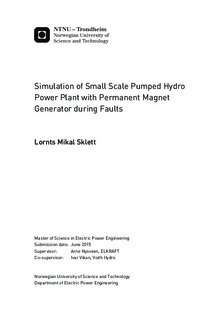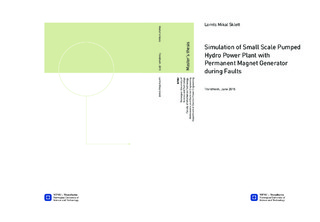| dc.description.abstract | This master thesis is a further investigation of the possibilities to utilize the permanent
magnet synchronous machine technology in small scale pumped hydro power, as a continuation
of the specialization project, fall 2014. The focus of this thesis is how the
pumped storage plant will operate during four different fault situations.
A theoretical survey is done to get a better understanding of how voltage and frequency
deviations in the synchronous machines connected grid affect in generator operation.
Available design criteria standards for synchronous generators are reviewed, and a summary
of these are formed. The fault period during a short circuit of a synchronous
machine has been set in focus, and the different torque contributions during and after
the short circuit fault have been investigated.
The simulation models are made in Matlab Simulink SimPowerSystems(MSPS), and the
corresponding control circuits for each of the simulation cases are developed here. Both
simulation models are established from existing blocks in the simulation program, one
with an electrical machine equipped with rotor damper windings and one without. Each
of the simulation cases are performed on both simulation models, and the results and
conclusions follow each of the four cases.
A full short circuit simulation case is done in both motor and generator operation. For
generator operation the results show that the generator that is equipped with damper
windings have a smaller rate of rise of the rotational speed increase during the fault, than
the generator without the damper windings. The damper windings contributes with a
speed reducing torque, which acts as an advantage in the generator mode of operation.
For motor operation the same effect is seen, that the motor with damper windings has a
larger speed reducing torque, and that the rotational speed has a steeper speed reduction
during the fault than for the model without damper windings. In motor operation this
effect leads to that the simulation model without damper windings is able to withstand
a longer short circuit on the machine terminals, than the model with damper windings,
because its speed deviation after the fault is smaller. In motor operation the damper
windings speed reducing torque is considered as a disadvantage.
For the simulation case during minor voltage and frequency variations, both of the
simulation circuits are able to withstand the tested simulation case. This shows that
the requirements for this simulation case are not the most demanding to meet with a
permanent magnet synchronous machine.
In the "fault-ride-through" test does none of the simulation circuits operate stable after the main test, with 85 % voltagedrop and a 0,40 seconds time duration at the lowest
voltage plateau. The FIKS requirements that are the background for this simulation
case are considered more demanding to fulfill with a permanent magnet synchronous
machine configuration. Since the simulation models consist of the electrical machine,
connected directly to the grid, an insertion of passive elements as transmission lines
or/and transformers between the grid and the electrical machine would add a damping
effect to the system, and possibly better simulation results.
The main conclusion is that damper winding are considered as a advantage both during
three phase short circuit and after a fault in generator operation. In motor operation
the result is more complex, where the damper winding contribute with a negative contribution
during a three phase short circuit, and with a positive effect after a fault. | |

